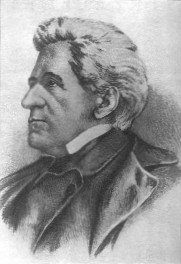Prominent Poles
Paweł Edmund Strzelecki (aka Sir Paul Edmund de Strzelecki) explorer, geographer, geologist.

Born: July 20, 1797, Gluszyna near Poznan, Prussian partition of Poland (presently Poland)
Died: October 6, 1873, London, England
Summary. He gained widespread recognition as an explorer as well as a philanthropist. He helped impoverished Irish families to seek new lives in Australia. He was also active in helping injured soldiers during the Crimean War.
Early days. Father, Franciszek Strzelecki, coat of arms Oksza, was a landowner; mother Anna nee Raczynska. Pawel was the youngest of three children: his sister Izabela was 8 years older, his brother Piotr was 4 years older. His father died in 1801 and after the death of his mother in 1807, his aunt took him to Warsaw. He studied in Pijars’ College for noblemen. In 1813 he went to Cracow and in 1817 moved to his siter’s estate in Skubarczewo. Then he served in the so-called “Polish Regiment” of the Prussian army. In 1820, after the rejection of his marriage proposal by the father of his beloved Adyna Turno, Strzelecki traveled around Europe. In 1825 he was offered a position of the manager of Count Franciszek Sapieha’s estates. In 1829 Count Sapieha died leaving Strzelecki a substantial legacy. It is believed that he then traveled to Russia, France and Africa.
Professional career. Australia. After the November Uprising against Russia in 1830, Strzelecki emigrated to London. During next three years he studied geology, anthropology, agronomy and other. In 1834 he left Liverpool on board a ship bound for New York.
He traveled around North America. Being especially interested in the culture and life of Indian tribes, he spent some time living with them and doing ethnographic research. On his visits to Canada he discovered copper ore at the Lake Ontario. In 1835 -1837 he researched the geology and meteorology of Brazil, Argentina, Uruguay and Chile. In 1838 he sailed to Marquises and Hawaii where he made extensive notes on rituals and customs of the indigenous population. In 1838 he traveled to Australia, where at the request of George Gipps, Governor of New South Wales, he made a geological and mineralogical survey of the Gippsland region of eastern Victoria. The Strzelecki Range in Gippsland are named in his honor. Later, in 1839 he set out on an expedition into the Australian Alps and explored the Snowy Mountains.
In 1839 Strzelecki visited New Zealand and then went to Sydney. He set off on a 3-month journey to the Blue Mountains, and Grose River. In the area of Bathurst he discovered gold and silver veins. He had not enough "time and men to trace them to their proper sources". On his return to Sydney Strzelecki reported to Governor Gipps and was asked not to reveal the gold discovery.
In 1840 he climbed the highest peak in Australia and named it Mount Kosciuszko, to honor Tadeusz Kosciuszko. In 1841 Strzelecki’s report for George Gipps was published in Parliamentary Papers in Sydney. He wrote: "…bad consequences… would accrue to the colony from the doing away with vegetation, by overstocking the pasturage, or by burning it, - a practice which, far from improving the grass, as some have imagined, only subtracts from the soil the most essential conductor of moisture, or medium of condensing it in the form of dew or shower."
Later in 1840 he sailed to Lauceston, Tasmania where, till 1843, he conducted geological exploration.
Return to London. In 1843 Strzelecki returned to London and in1845 he becames a British citizen. In 1845 he published his Physical Description of New South Wales and Van Diemen's Land,
In 1847 he went to Ireland as an agent of the British Association for the Relief of Extreme Distress in Ireland and Scotland. Delegated to Dublin as a Commissioner, he began organizing bakeries, introducing new edible alternatives to potatoes, and feeding children in schools.
In 1866 Strzelecki met Adyna in Geneva, Switzerland. In 1873 he died in London because of an incurable liver disease. He was buried at the Kensal Greens Cemetery
Honors and awards. 1846 The Royal Geographical Society awards Strzelecki a Gold Founders medal and displays his huge geological map of NSW and Tasmania for public viewing.
1848 For his services during the famine in Ireland, Strzelecki was named Knight Companion of the Bath
1853 Member of the Royal Geographic Society
1860 An honorary degree of Doctor of Civil Law from the University of Oxford
1869 Title of Knight Commander of the Most Distinguished Order of St. Michael and St. George for his "five years'
explorations in Australia, the discovery of gold, the discovery of new territory accessible to colonization, and finally for the construction of topographical and geological maps, based on astronomical observations."
Several geographical features in Australia were named after Strzelecki (in Australia his last name and things named after him are pronounced "Strezleky."):
Strzelecki Range in Victoria
Mount Strzelecki in Northern Teritory
Strzelecki Peak in Flinders Island
Strzelecki Creek in South Australia
Strzelecki Desert east of Lake Eyre
Strzelecki Regional Reserve within Strzelecki Desert
Strzelecki village
Also a Canadian bay is named Strzelecki Harbour.
Poland issued in 1973, 1987 and 1997 postage stamps featuring Pawel Strzelecki
Based on an article that appeared in Wikipedia (all text is available under the terms of the GNU Free Documentation License):
Wikipedia
Other sources:
Mt. Kosciuszko Inc.
Muzeum Geologiczne
Gutenberg
onet.pl (in Polish)
Lech Paszkowski
Return to home page:
Prominent Poles
